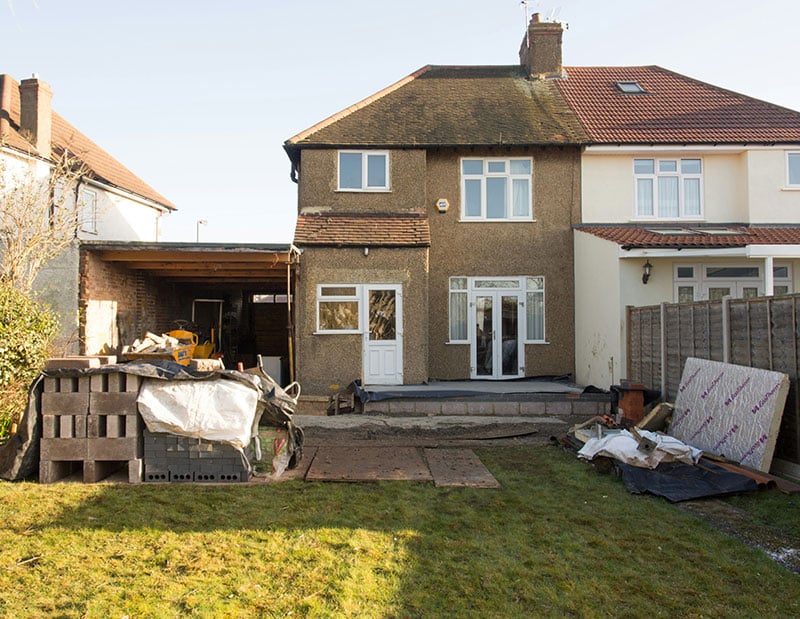Does home insurance cover asbestos?
Before the hazardous health impacts of asbestos were widely known and understood, it was a commonly used material in building construction of both commercial and residential structures.
Though newer buildings — those built in 2000 and later — should not contain any asbestos due to the ban, older buildings that have not been fully renovated to remove the asbestos could likely have asbestos-containing materials (ACMs).
While some ACMs don’t pose an immediate threat, particularly if they’re in undamaged and undisturbed condition, there are many cases where ACMs must be removed to ensure the safety of the home’s occupants.
When asbestos removal is necessary, is it covered by home insurance costs? We’ll explore that question in this article.
What is asbestos, and why is it a concern in homes?
Asbestos is a naturally occurring fibre, and it once made an excellent addition to common building materials because it’s strong and fireproof. It was also inexpensive and easily accessible. This meant it was used often and in many different construction elements.
Unfortunately, asbestos exposure can lead to life-threatening cancers and other diseases several decades in the future. Once the toxic nature of asbestos was understood, the UK banned it.
Today, though, many older homes built before the asbestos ban in 1999 still have ACMs.
Where is asbestos found in homes?
There are a number of building materials and household items that may contain asbestos depending on when they were built, including:
- Artificial ashes and embers in gas fireplaces
- Loft and wall insulation
- Ceiling and floor tiles
- Cement
- Door gaskets for appliances
- Flooring materials, including linoleum
- HVAC duct insulation
- Joint compound
- Pipes
- Shingles
- Window caulking
Asbestos was commonly used in these materials because it’s durable and fire-resistant.
A home insurance policy is most likely to cover asbestos ceiling or floor materials that are impacted by a sudden incident like a flood or other type of water damage.
Do standard home insurance policies typically cover asbestos?
In general, basic home insurance policies in the UK don’t cover asbestos removal, even if the ACMs pose a risk.
Since asbestos-related health issues are well-known and mainly associated with long-term exposure (as opposed to one-time or limited exposure), insurance companies don’t consider adverse health effects related to asbestos to be sudden or unforeseeable.
As a result, insurance companies feel that homeowners are able to get the information and help they need to mitigate the risk. With proper asbestos management and maintenance, a dangerous exposure event can likely be avoided.
Because the homeowner has so much control over how ACMs are handled on their property, they’re also responsible for paying for asbestos remediation or removal.
Under what circumstances might home insurance cover asbestos removal?
Like with most things, there are exceptions and times when a home insurance policy may cover asbestos remediation.
If the need for asbestos removal is connected to an event that’s covered by insurance, like a flood, the asbestos work may be covered along with the flood damage. This is because the flood, not the ACM, is what caused the asbestos work to be required.
As a real-life example, Admiral Buildings Insurance will “rebuild, repair or replace parts of the buildings damaged by the causes covered under the policy.” If those parts contain ACMs, then remediation may be included in the coverage.
When you make a claim that includes asbestos damage, your insurance company may appoint a licensed asbestos expert to assess the area. From there, removal may be set up if the insurance company decides to cover it.
In some cases, asbestos removal will still not be covered even if the need for removal is connected to a covered event. According to Admiral Buildings Insurance, removal is not covered “in the case of boiler repair or a home emergency call-out [such as] emergency repairs on your roof due to storm damage.”
Is partial coverage for asbestos removal worth it?
If an insurance policy does cover asbestos removal in a specific circumstance, it may only pay for part of the removal, not the entire cost. Your policy should include information about if and when asbestos removal is covered, along with how much the insurance company will pay toward the work.
Even partial coverage is worth submitting a claim for if your insurance company is willing to pay a percentage of the cost.
All types of asbestos are dangerous, and there’s no such thing as a safe asbestos exposure incident. If ACMs in your home need remediation, the safest option is always to hire an asbestos expert or team to handle it for you.
However, since professional asbestos removal can be costly, any amount you can save will be worthwhile. Asbestos costs include:
- Expert-level labour
- Specialised equipment
- Handling and disposing of asbestos waste
- Necessary permits to stay compliant
Proper asbestos removal is expensive. If you find an asbestos removal company that seems to charge much less than its competitors, consider that a red flag. Some removal “experts” cut costs by not having insurance or failing to safely handle asbestos.
What is covered in typical home insurance policies?
Home insurance policies generally cover many types of risks that could damage a home, such as:
- Explosions
- Falling objects
- Fire and smoke
- Flooding
- Lightning
- Plumbing leaks
- Theft and vandalism
Different insurers and policies will have different coverages and options. It’s important to carefully read and understand your options and policy so you know what is and is not covered.
If you’re not able to find the information you’re looking for or you don’t understand how the policy is worded, speak with your insurance provider to get clarity.
What is not covered in typical home insurance policies?
There are exceptions when it comes to the events that home insurance covers. Many home insurance policies will not cover the following:
- Animal damage, like from pets or rodents
- Earth movements, like earthquakes and sinkholes
- Intentional damage
- Normal wear and tear
- Nuclear events
As mentioned, some natural events or acts of vandalism are covered by insurance. If those scenarios lead to asbestos damage that requires removal, the asbestos work may be covered by insurance.
However, there are also natural events and sudden situations that are not covered by insurance. Even if those events lead to asbestos damage that wouldn’t have otherwise occurred, the asbestos removal won’t be covered by insurance because the initial event is not covered.
What should homeowners do if asbestos is discovered in their home?
If your home was built before 2000, you may be worried that there are ACMs that present an exposure risk. Being proactive is the best way to keep you and your family safe. Here’s what to do if you discover asbestos in your home:
Don’t remove the ACM yourself
Proper handling and disposing of asbestos is crucial in order to stay safe. If you try to remove the ACM on your own, you could inhale the fibres yourself and unknowingly release them into the rest of the home, where others will also be exposed.
Don’t disturb the area
Asbestos fibres are dangerous once they’re airborne, which happens when the ACM is damaged or disturbed.
Limit access to the area
If possible, close off access to the area with the ACM. This will prevent anyone in the home from accidentally disturbing it and inhaling dangerous fibres.
Inform the other household members
Let anyone who lives with you know that asbestos has been found, where it is, and how to avoid it. Explain the health impacts that asbestos can have so that everyone knows how serious the situation is.
Contact a professional
Hire a certified asbestos expert or team to visit your home. They’ll assess the situation and make recommendations for what should be done next. Together, you can come up with a removal plan.
Monitor your health
Asbestos fibres don’t have a smell or taste, so it’s possible to inhale or ingest them without realising it. Once you know that there’s asbestos in your home, it’s important to keep track of your own respiratory health. Pay attention to any health issues, particularly respiratory issues, that arise.
If you’re at all concerned that your health has been affected by asbestos exposure, contact your doctor or an asbestos health specialist immediately.
Wrapping up
Asbestos is a common material in older homes built before 2000. If you discover damaged or disturbed asbestos in your home and need to hire a removal expert, you’ll want to know whether or not the process is covered by insurance.
In general, home insurance coverage doesn’t include asbestos removal. However, if asbestos removal is necessary because ACMs have been damaged by a covered incident, your insurance company may cover some part of the removal cost.
Thoroughly read your coverage documents and speak with your contact personal at the insurance company. Don’t assume that the asbestos removal project is not covered. It pays to find out for sure since asbestos removal can be a costly endeavour.
To speak with an asbestos removal expert or get a free quote for your project, contact us today.

Written by Jess Scott
Jess Scott has been an all-round asbestos consultant since 1996. That’s nearly 3 decades of asbestos knowledge. He spends his time sharing that knowledge with the team at Oracle and with their clients. Jess's goal is, and always has been, to use my expertise in helping people to comply with the law. This legal compliance ultimately helps to protect everyone from the harmful effects of asbestos. Jess has acted as an asbestos expert witness in legal cases and is involved in many asbestos educational activities throughout the UK.

